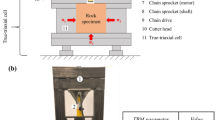Abstract
Predicting the ground response for tunnels in weak shales remains challenging. Predicting the ground response is challenged by difficulties in characterising the material, and our ability to predict deformations that are driven by coupled hydromechanical processes, when this material yields. The techniques that are used for characterising weak shales are reviewed, and three case histories are examined that demonstrate the behaviour of these weak rocks during tunnelling. A general framework is provided for assessing the squeezing potential for weak shales.























Similar content being viewed by others
References
Amann F, Kaiser PK, Button EA (2012) Experimental study of brittle behavior of clay shale in rapid triaxial compression. Rock Mech Rock Eng 45(1):21–33
Armand G, Noiret A, Zghondi J, Seyedi DM (2013) Short- and long-term behaviors of drifts in the Callovo-Oxfordian claystone at the Meuse/Haute-Marne underground research laboratory. J Rock Mech Geotech Eng 5(3):221–230
Bernier F, Li XL, Bastiaens W (2007) Twenty-five years’ geotechnical observation and testing in the tertiary boom clay formation. Géotechnique 57(2):229–237
Bock H, Dehandschutter B, Martin CD, Mazurek M, de Haller A, Skoczylas F, Davy C (2010) Self-sealing of fractures in argillaceous formations in the context of geological disposal of radioactive waste. NEA 6184. Nuclear Energy Agency Organisation for Economic Co-Operation and Development
Chern, JC, CW Yu, Shiao FY (1998) Tunnelling in squeezing ground and support estimation. In: Proceedings of the regional symposium on sedimentary rock engineering, Taipei, pp 293–297
Cornish LJ, Moore DP (1985) Dam foundation investigations for a project on soft shale. In: Proceedings of 38th Canadian geotechnical conference, Edmonton, pp 171–178
Einstein HH (1996) Tunnelling in difficult ground-swelling behaviour and identification of swelling rocks. Rock Mech Rock Eng 29(3):113–124
Gschnitzer E, Goliasch R (2009) TBM modification for challenging rock conditions—a progress report of the Niagara Tunnel Project (NTP). Geomech Tunn 2(2):68–78
Hoek E, Guevara R (2009) Overcoming squeezing in the Yacambú-Quibor tunnel. Venezuela. Rock Mech Rock Eng 42(2):389–418
Hoek E, Marinos P (2000) Predicting tunnel squeezing problems in weak heterogeneous rock masses—part 2: potential squeezing problems in deep tunnels. Tunn Tunn Int 32(11):45–51
Holtz RD, Kovacs WD, Sheahan TC (2011) An introduction to geotechnical engineering, 2nd edn. Pearson/Prentice Hall, Upper Saddle River, NJ
Imrie AS (1991) Stress-induced response from both natural and construction-related processes in the deepening of the Peace River Valley, BC. Can Geotech J 28(5):719–728
Lanyon GW, Martin CD, Giger S, Marschall P (2014) Development and evolution of the Excavation damaged zone (EDZ) in the Opalinus clay—a synopsis of the state of knowledge from Mont Terri. Nagra Report NAB, pp 14–87
Little TE (1989) Construction and performance of a large diameter test chamber in shale. In: Lo KY (ed) Proceedings of international congress on progress and innovation in tunnelling, vol II, Toronto, pp 869–876
Macciotta R, Martin CD, Elwood D, Lan H, Vietor T (2012) Measured convergence at a test tunnel in the Opalinus clayshale formation. In: CD-ROM proceedings of 21st Canadian rock mechanics symposium, RockEng 2012, Edmonton
Martin CD, Kaiser PK, McCreath DR (1999) Hoek–Brown parameters for predicting the depth of brittle failure around tunnels. Can Geotech J 36(1):136–151
Perras MA, Diederichs MS (2015) Observations and numerical back analysis of an excavation in the Queenston mudstone. In: Proceedings 13th ISRM congress, Montreal, pp 1–12
Perras MA, Diederichs MS, Besaw D (2014) Geological and geotechnical observations from the Niagara Tunnel Project. Bulletin of Engineering Geology and the Environment, pp 1–21
Santi PM (2006) Field methods for characterizing weak rock for engineering. Environ Eng Geosci 12(1):1–11
Sargent DW, Cornish LJ (1985) Water susceptibility of Shaftesbury shale. In: Proceedings of 38th Canadian geotechnical conference, Edmonton, pp 197–206
Underwood LB (1967) Classification and identification of shales. ASCE J Soil Mech Found Div 93(SM6):97–116
Wild KM, Wymann LP, Zimmer S, Thoeny R, Amann F (2014) Water retention characteristics and state-dependent mechanical and petro-physical properties of a clay shale. Rock Mech Rock Eng 48(2):427–439
Acknowledgments
The author wishes to thank Tom Lam (NWMO) for compiling the properties of the Queenston Shale, Dr. Matt Perras for providing Fig. 19 and Dr. Evert Hoek for his review comments.
Author information
Authors and Affiliations
Corresponding author
Rights and permissions
About this article
Cite this article
Martin, C.D., Giger, S. & Lanyon, G.W. Behaviour of Weak Shales in Underground Environments. Rock Mech Rock Eng 49, 673–687 (2016). https://doi.org/10.1007/s00603-015-0860-5
Received:
Accepted:
Published:
Issue Date:
DOI: https://doi.org/10.1007/s00603-015-0860-5




